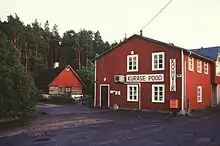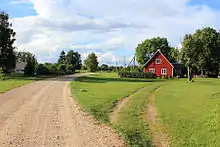Kihnu
Kihnu is an island in the Baltic Sea. With an area of 16.4 km2 (6.3 sq mi) it is the largest island in the Gulf of Riga[2] and the seventh largest island of Estonia. The length of the island is 7 km (4.3 mi) and width 3.3 km (2.1 mi), the highest point is at 8.9 metres (29.2 ft) above sea level.
Kihnu
Kihnu Kynö | |
|---|---|
Island | |
 Gulf of Riga, with Kihnu and other islands | |
 Kihnu Location of Kihnu within Estonia | |
| Coordinates: 58°07′48″N 23°59′24″E | |
| Country | |
| Region | Pärnu County |
| Municipality | Kihnu Parish |
| Area | |
| • Total | 16.38 km2 (6.32 sq mi) |
| Elevation | 29.6 m (97.1 ft) |
| Population (2013) | |
| • Total | 490 |
| • Density | 30/km2 (77/sq mi) |
| Time zone | UTC+2 (EET) |
| • Summer (DST) | UTC+3 (EEST) |
| Postal codes | 88005 |
The island belongs to the Pärnu County of Estonia. Together with neighbouring islands it forms Kihnu Parish, one of the smallest municipalities of the country with an area of 16.8 km2 (6.5 sq mi).
604 people live on Kihnu as of 2007 of whom 69 are primary school pupils. There are four villages: Lemsi, Linaküla, Rootsiküla and Sääre. One can reach Kihnu by plane from Pärnu (15 minutes) or ferry from either Pärnu (3 hours) or Manilaid (1 hour), and when the sea is frozen in winter it is possible to drive to the island over the ice.
The nearby isle of Manilaid (or Manija, Manõja in the Kihnu dialect) was inhabited by people from Kihnu in 1933 and thus shares its culture.
UNESCO proclaimed Kihnu's cultural space and traditions as a Masterpiece of the Oral and Intangible Heritage of Humanity on November 7, 2003. [3]
Kihnu is also called Kihnumua (e.g. "Kihnuland") in the local dialect. Names in other languages include Ķīļu in Latvian, Kynö in Standard Swedish, Kin in Estonian Swedish, and historically Kühnö in German. In Estonian Sign Language, the island is signed by imitating the vertical stripes of a Kihnu skirt. There are various theories on the etymology of the name Kihnu, with no consensus. The earliest recorded version of the island's name is Kyne, from 1386.[4]
Culture
As the men of Kihnu have been frequently away to sea, women have run everyday life on the island and became the guardians of the island's cultural heritage, which includes handicrafts, dances, games and music. Music is an especially important part of the island's traditions, and accompanies handicrafts, religious feasts and other celebrations. Ancient runo-styled songs are also important, as is traditional clothing adorned with decorations and bright colours. There are elaborate wedding traditions, which are considered the "most complex and bright expression" of Kihnu culture.[5]
Kihnu is famous for its handicrafts and distinctive traditional clothing, which is still commonly worn today. It includes striped skirts (kört), and patterned knit men's sweaters (troi), and knit mittens. Young women have traditionally organised evening get-togethers (ülalistmine, i.e. "sitting (staying) up (late)") to do handicrafts.
Traditional cuisine includes rye bread with potatoes, pork fat or Baltic herring added to the dough; eel soup, prepared by fishermen; and sweet milk soup, an important dish in weddings.[6] Seal hunting is practiced in Kihnu, and their meat is considered a delicacy. Another distinctive delicacy is the eggs of semi-domesticated mergansers (waterbirds), also used for baking cakes.
In the 19th and early 20th century, numerous men from Kihnu became sailors. The most famous of them was the largely self-taught captain Enn Uuetoa, also known as Kihnu Jõnn (1848 – 1913; Jõnn is the local pronunciation of the name Enn).
Language
The Kihnu dialect is considered to belong to the insular dialect group of North Estonian, along with the dialects of Saaremaa, Muhu and Hiiumaa. It is unusual among North Estonian dialects in preserving vowel harmony, like most other Finnic languages. The dialect includes triphthongs. There are Swedish influences in vocabulary and intonation.
Geography and climate
The island has a sandy interior and a rocky coast made up of more than fifty islets which make up an important nesting ground for birds. Along the dunes, beach ridges and sands of the eastern part the island reaches its maximum height of 29.6 m above sea level.[1]
| Climate data for Kihnu (1981–2010) | |||||||||||||
|---|---|---|---|---|---|---|---|---|---|---|---|---|---|
| Month | Jan | Feb | Mar | Apr | May | Jun | Jul | Aug | Sep | Oct | Nov | Dec | Year |
| Record high °C (°F) | 8.1 (46.6) |
6.3 (43.3) |
15.0 (59.0) |
23.9 (75.0) |
29.2 (84.6) |
30.6 (87.1) |
31.8 (89.2) |
29.5 (85.1) |
23.3 (73.9) |
17.5 (63.5) |
12.0 (53.6) |
9.0 (48.2) |
31.8 (89.2) |
| Average high °C (°F) | −0.3 (31.5) |
−1.5 (29.3) |
1.3 (34.3) |
7.1 (44.8) |
13.7 (56.7) |
17.6 (63.7) |
20.7 (69.3) |
20.1 (68.2) |
15.3 (59.5) |
10.2 (50.4) |
4.7 (40.5) |
1.6 (34.9) |
9.2 (48.6) |
| Daily mean °C (°F) | −2.1 (28.2) |
−3.5 (25.7) |
−1.0 (30.2) |
3.9 (39.0) |
10.1 (50.2) |
14.5 (58.1) |
17.9 (64.2) |
17.5 (63.5) |
13.1 (55.6) |
8.3 (46.9) |
3.2 (37.8) |
−0.1 (31.8) |
6.8 (44.2) |
| Average low °C (°F) | −4.1 (24.6) |
−5.6 (21.9) |
−3.2 (26.2) |
1.6 (34.9) |
7.5 (45.5) |
12.0 (53.6) |
15.4 (59.7) |
15.2 (59.4) |
10.9 (51.6) |
6.6 (43.9) |
1.5 (34.7) |
−2 (28) |
4.6 (40.3) |
| Record low °C (°F) | −32.4 (−26.3) |
−30.8 (−23.4) |
−20.6 (−5.1) |
−8.5 (16.7) |
−1 (30) |
3.2 (37.8) |
8.0 (46.4) |
7.0 (44.6) |
0.6 (33.1) |
−5.4 (22.3) |
−14.5 (5.9) |
−19.6 (−3.3) |
−32.4 (−26.3) |
| Average precipitation mm (inches) | 37 (1.5) |
29 (1.1) |
30 (1.2) |
30 (1.2) |
34 (1.3) |
58 (2.3) |
65 (2.6) |
66 (2.6) |
62 (2.4) |
64 (2.5) |
58 (2.3) |
45 (1.8) |
578 (22.8) |
| Average relative humidity (%) | 87 | 87 | 86 | 81 | 77 | 80 | 80 | 80 | 81 | 83 | 86 | 87 | 83 |
| Source: Estonian Weather Service[7][8][9] | |||||||||||||
Images of Kihnu


Church 
An inn 
Seashore 
Museum 
Village road 
Garden 
A view of the coastline 
Young girls in both modern and traditional dress returning from school. 
Pine forest 
Cemetery 
An adult grey seal on drift ice just off of the Kihnu coast.
See also
References
- "The islands in the Väinameri Sea and the Gulf of Riga". Estonica. Eesti Instituut. September 28, 2012. Retrieved February 20, 2018.
- C.Michael Hogan. 2011. Gulf of Riga. Encyclopedia of Earth. Eds. P.Saundry & C.J.Cleveland. National Council for Science and the Environment. Washington DC.]
- "Kihnu cultural space - intangible heritage". UNESCO.
- Dictionary of Estonian Place names.
- "Kihnu wedding". Kihnu Cultural Space. Retrieved 23 July 2020.
- "Food". Kihnu Cultural Space. Retrieved 23 July 2020.
- "Climate normals-Temperature". Estonian Weather Service. Retrieved 27 September 2016.
- "Climate normals-Precipitation". Estonian Weather Service. Retrieved 27 September 2016.
- "Climate normals-Humidity". Estonian Weather Service. Retrieved 27 September 2016.
External links
| Wikimedia Commons has media related to Kihnu. |
| Wikivoyage has a travel guide for Kihnu. |

